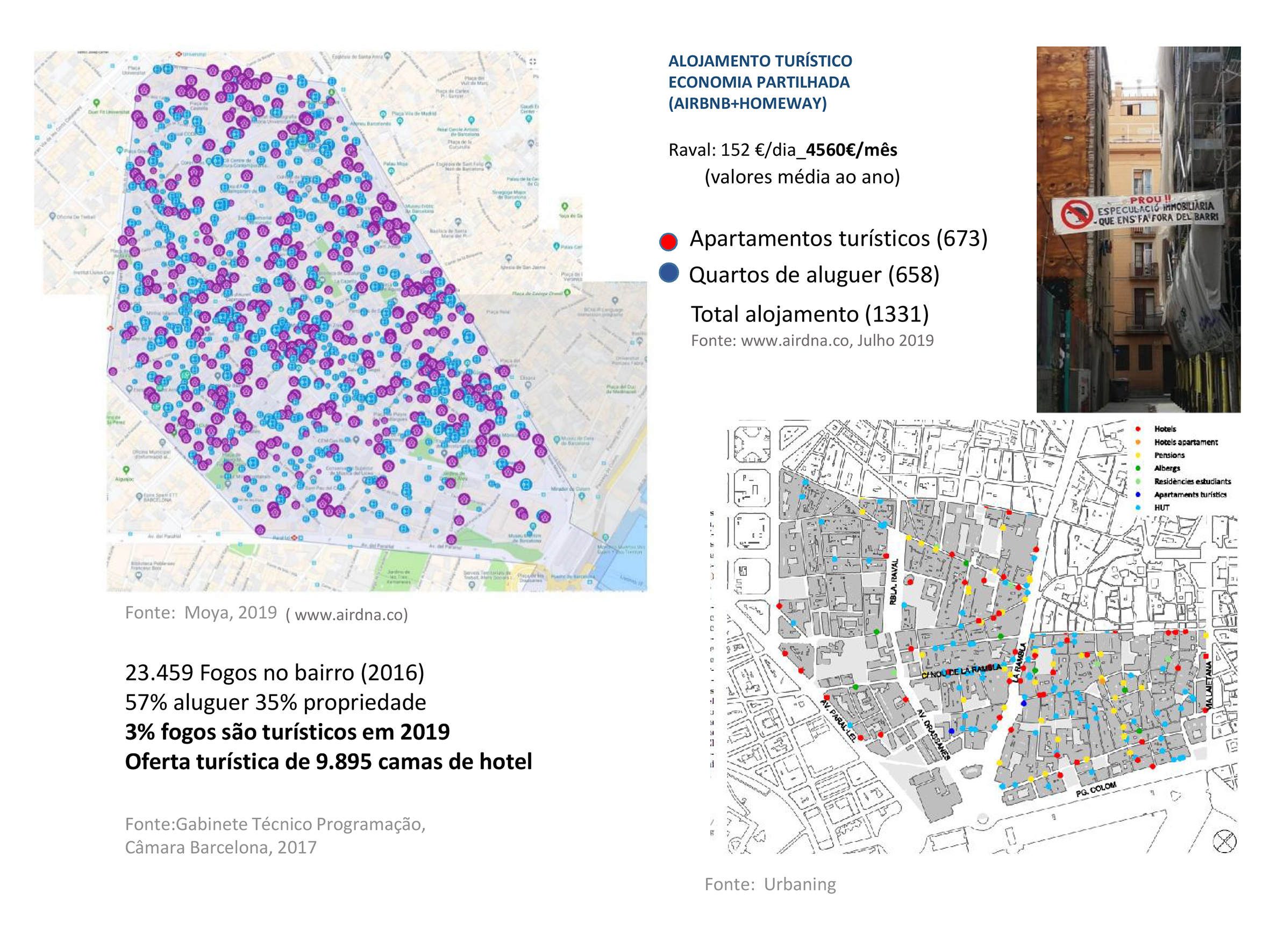+ info Raval
+ info raval
Raval is a multicultural urban landscape that contains a patchwork of spaces informed and formed by differentiated cultural heritages and identities. From the 2000’s onwards, the historical tangible and intangible identity of its urban heritage has been transformed greatly due to the increased movement of people and communities arising from increased levels of social migration, immigration and city tourism. Raval includes 47.617 inhabitants (stats. from 2015 data) with 122 different nationalities and 47,9% of its population are from other countries outside of Spain (Barcelona’s Statistics Department, 2016). The main places of origin are Pakistan (10,8%), Philippines (8,5%), Bangladesh (5%), Italy (3%), Morocco (2,8%) and India (2%). The European citizens living in Barcelona tend to be young qualified residents (60% of them have between 25 to 40 years old with University degrees), and they correspond to 30,8% of the foreign population living in Barcelona. What emerges from this data is a picture of an ethnically rich and diverse area where a wide range of nationalities, customs and traditions converge and coexist. Raval has an open institutional atmosphere of intercultural dialogue and integration. This intercultural identity is an important asset with associated attractive values for urban tourism and the consumption of urban experiences.

Bibliography:
Pla de Desenvolupament Econòmic Ciutat Vella 2016-2021 [Ciutat Vella Economic Development Plan 2016-2021]. Ajuntament de Barcelona, Districte Ciutat Vella. Barcelona Activa. (http://ajuntament.barcelona.cat/ciutatvella/pla-desenvolupament-economic/ca/home)
Moya Pellitero, A.M; Hunter, V. (2020) “Somatic landscapes and urban identities: mapping emotional engagements through site, dance and body connections in Raval, Barcelona, a case study”. In Athens Journal of Architecture, Vol.6, Issue. 3, July 2020, pp.249-272.
Regarding the economic activities in Raval, statistical data in 2015 determine that the majority of activities at street level were services (46,4%), commerce (31,8%) and empty spaces (15,7%). Service activities were restaurant businesses and lodging. The area contains, at the present, a large number of touristic residences, with 9.896 accommodations including hotels, hostels, touristic apartments and youth hostels (Economic Development Plan for Ciutat Vella 2016-2021). In 2016, the sociological indicator of touristic presence in the neighborhood demonstrated 123,2 tourists for every 1000 inhabitants (Socioeconomic indicators 2016, Raval, Ciutat Vella District )[1]. Raval is divided in two municipal management sectors, Raval North and Raval South. Raval South is an under privileged area with high levels of poverty, and social exclusion. The unemployment rates moves between 11,1% and 13%, with low family incomes between 63-79 in an index of 100. Urban gentrification processes and real estate investment with a tourist pressure for those existing apartments of first residence, has created a vulnerable situation for this fragile population, with eviction levels averaging between 9,1% to 19,7% (Map of Neighborhoods South Raval and South Gothic, 2017)[2].
Bibliography:
[1] Indicadors socioeconomics 2016, districte de Ciutat Vella. Barri el Raval [Socioeconomic indicators, 2016, Ciutat Vella District, Raval neighbourhood. (http://www.bcn.cat/estadistica/castella/dades/inf/barris/a2016/barri1.pdf).
[2] Pla de Barris el Raval Sud i el Gòtic Sud, 2017. [Map of Neighborhoods South Raval and South Gothic] Ajuntament de Barcelona. Districte Ciutat Vella. (http://pladebarris.barcelona/plans-de-barri/raval-sud-i-gotic-sud)
Moya Pellitero, A.M; Hunter, V. (2020) “Somatic landscapes and urban identities: mapping emotional engagements through site, dance and body connections in Raval, Barcelona, a case study”. In Athens Journal of Architecture, Vol.6, Issue. 3, July 2020, pp.249-272.
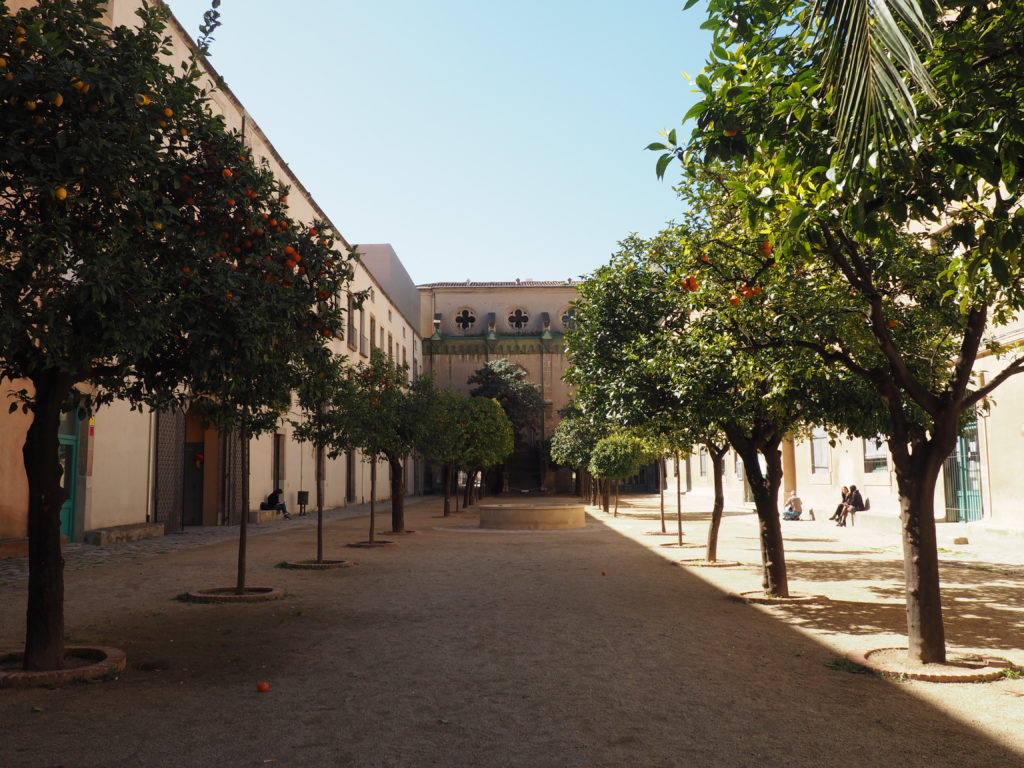 From 1250 to the1600’s, Raval was a walled perimeter suburban area of Barcelona with a rich agricultural land and wetlands with Cagalell pond located in the South, collecting the water of seasonal streams. The third city walls that enclosed Raval (1348), enabled urban growth and provided agricultural land for self-subsistence in times of siege. Within the enclosure, existing hospitals and convents remained along the main accesses of circulation (Carme Street, Hospital Street, Tallers Street, and Sant Pau Street). Sant Pau del Camp Monastery, which dates from the 10th century, is the oldest religious nucleus that still exists and maintains a religious use today. Two important Gothic infrastructures have a prominent and symbolic presence in the neighborhood. One is the shipyard building Drassanes, rebuilt in the 16th century in the same location of the medieval 11th century building. The second is the Old Hospital of Santa Creu, dating from 1401. This was the only city hospital until the beginning of the 20th century, following which the hospital moved to the city outskirts and at the present is the Library of Catalonia. During the second half of the 16th century to the first of the 17th, Raval consolidated as a territory of convents and monasteries encompassing a wide diversity of religious orders. Right image: Courtyard of Sant Guillem d’Aquitania Convent, now Laboure School, in Raval North. Source: A. Moya.
From 1250 to the1600’s, Raval was a walled perimeter suburban area of Barcelona with a rich agricultural land and wetlands with Cagalell pond located in the South, collecting the water of seasonal streams. The third city walls that enclosed Raval (1348), enabled urban growth and provided agricultural land for self-subsistence in times of siege. Within the enclosure, existing hospitals and convents remained along the main accesses of circulation (Carme Street, Hospital Street, Tallers Street, and Sant Pau Street). Sant Pau del Camp Monastery, which dates from the 10th century, is the oldest religious nucleus that still exists and maintains a religious use today. Two important Gothic infrastructures have a prominent and symbolic presence in the neighborhood. One is the shipyard building Drassanes, rebuilt in the 16th century in the same location of the medieval 11th century building. The second is the Old Hospital of Santa Creu, dating from 1401. This was the only city hospital until the beginning of the 20th century, following which the hospital moved to the city outskirts and at the present is the Library of Catalonia. During the second half of the 16th century to the first of the 17th, Raval consolidated as a territory of convents and monasteries encompassing a wide diversity of religious orders. Right image: Courtyard of Sant Guillem d’Aquitania Convent, now Laboure School, in Raval North. Source: A. Moya.
 At the start of the 19th century, Raval underwent a gradual change in its physiognomy becoming a polluted and dense industrial area with hundreds of chimneys of cotton textile factories. In 1835, most of Raval’s convents were demolished, expropriated and replaced by buildings such as La Boqueria food market or Liceu Opera House. Other convents survived but changed their use such as Labouré Primary School (Sant Guillem d’Aquitania Convent); or to cultural buildings such as the Museum of Contemporary Art of Barcelona (MACBA) (Angels Convent) and the Center of Contemporary Culture of Barcelona (CCCB) (Natzaret Monastery). In the 19th century, the textile industry developed the city through the concentration of intense urban, commercial and manufacturing activity in the neighborhood. Factories and residential buildings for workers appeared, including factory-homes, where workers had also their residence. Raval became densely populated and suffocated by its walls because the city could not grow outside the limits due to military impositions. Left image: Raval’s historical cartographies. Fragment of the Plan of the City and Port of Barcelona, by Moulinier (1806); and Fragment of the General Plan of Barcelona and its Urban Expansion (1900). Source: Cartographic and Geological Institute of Catalonia.
At the start of the 19th century, Raval underwent a gradual change in its physiognomy becoming a polluted and dense industrial area with hundreds of chimneys of cotton textile factories. In 1835, most of Raval’s convents were demolished, expropriated and replaced by buildings such as La Boqueria food market or Liceu Opera House. Other convents survived but changed their use such as Labouré Primary School (Sant Guillem d’Aquitania Convent); or to cultural buildings such as the Museum of Contemporary Art of Barcelona (MACBA) (Angels Convent) and the Center of Contemporary Culture of Barcelona (CCCB) (Natzaret Monastery). In the 19th century, the textile industry developed the city through the concentration of intense urban, commercial and manufacturing activity in the neighborhood. Factories and residential buildings for workers appeared, including factory-homes, where workers had also their residence. Raval became densely populated and suffocated by its walls because the city could not grow outside the limits due to military impositions. Left image: Raval’s historical cartographies. Fragment of the Plan of the City and Port of Barcelona, by Moulinier (1806); and Fragment of the General Plan of Barcelona and its Urban Expansion (1900). Source: Cartographic and Geological Institute of Catalonia.
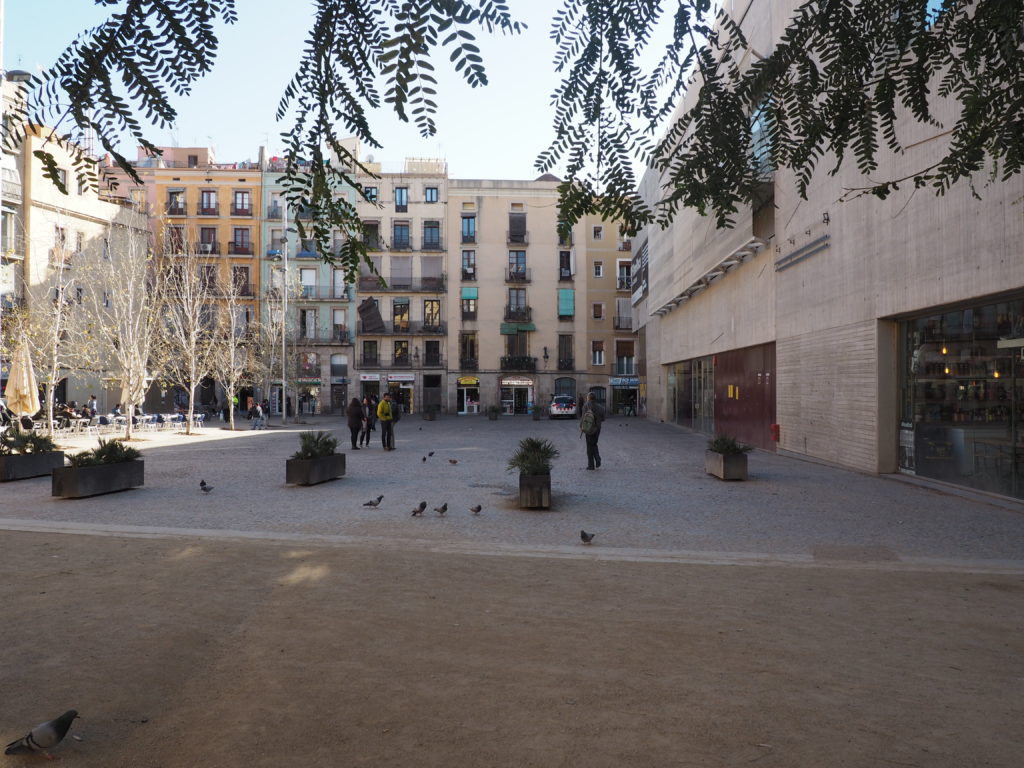
Following the demolition of the city walls in 1859, the industrial interests moved out of the city center. During the beginning of the 20th century, Raval became a lower working class residential neighborhood and home for a number of national immigrants who arrived to Barcelona for the construction of the Universal Expositions of 1888 and 1929. Raval up to the 1980’s remained a densely populated neighborhood with a proliferation, especially in South Raval, of brothels and nightlife establishments. After the Civil War (1939), Raval had an intense national migratory growth. During the dictatorship and until 1974, the area was considered one of the most dangerous neighborhoods in the city. Urban plans were implemented in the 1980’s, with the approval of the General Metropolitan Master Plan to develop the area. The vertical axis of Drassanes Avenue was opened in South Raval, which gave an urban frame to the first city skyscraper, Colon Office Tower (1970) and other institutional buildings, with the creation of squares and gardens, with the demolition of the National Prison for the construction of Folch i Torres Square or Can Ricart Factory for the construction of Sant Pau del Camp Gardens. Right image: Salvador Seguí square with Catalonia Film Library in May 2018. Source: A. Moya
New infrastructures were built leading to the celebration of the Olympic Games (1992), with the construction of Faculties and services of the University of Barcelona in North Raval, and MACBA facilities in Angels Square. Following the economic crisis of the mid 1990’s up to 2004, and later from 2008 onwards, the combination of urban renewal, economic development and social cohesion initiatives became problematic. The most emblematic interventions in this period are the demolitions of buildings in the heart of the neighbourhood to open Rambla del Raval, Salvador Seguí Square and Vázquez Montalbán Square, with cultural, public and private infrastructures, such as Hotel Barceló Tower, the Catalonia Film Library, and the Liceu Conservatory. One of the latest interventions, in 2015, has been the remodeling of Gardunya Square, at the back of La Boqueria market, and the construction of Massana Art’s school.
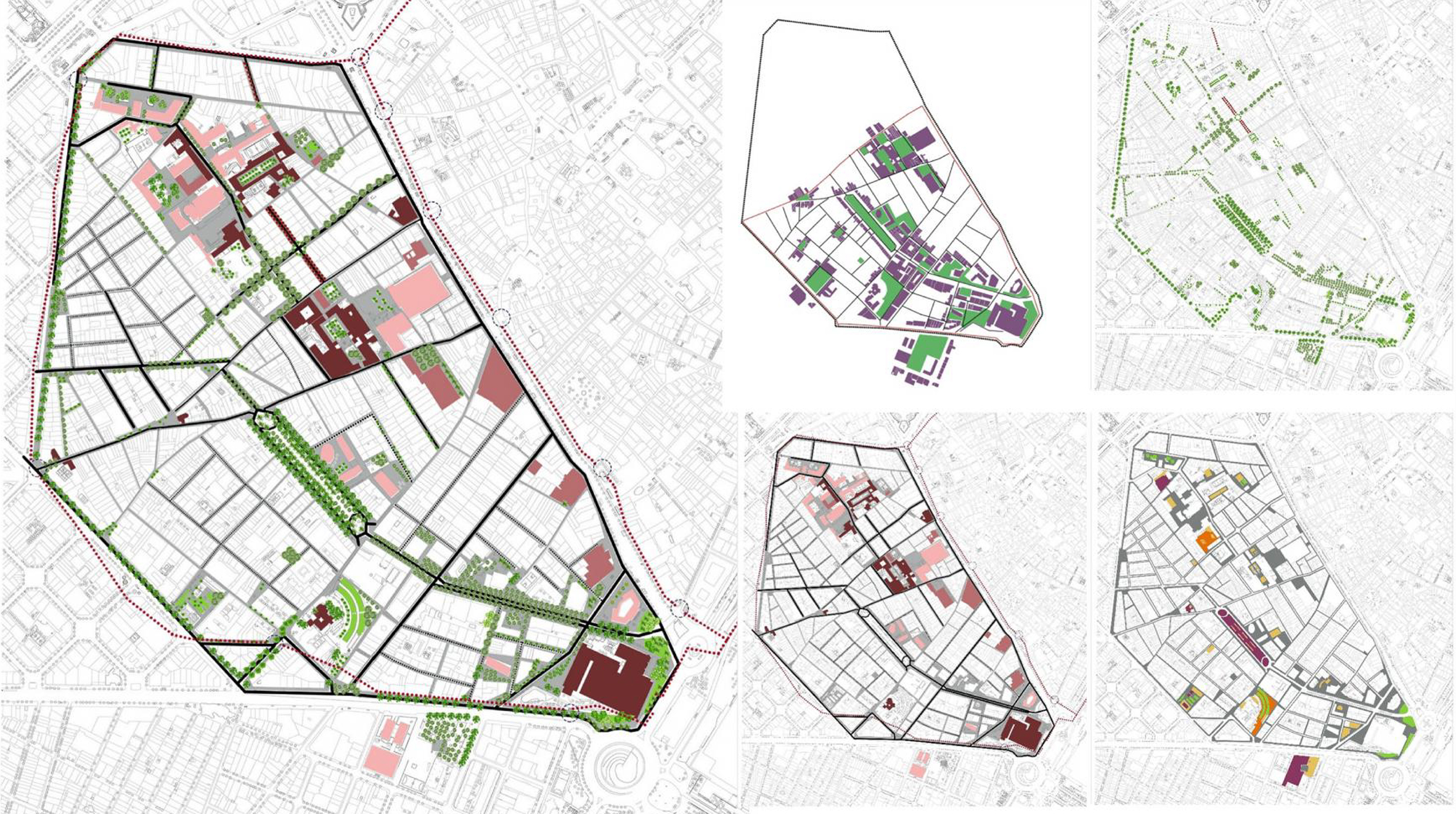
Bibliography:
Busquets, J. (et.al.) 2003. The Old Town of Barcelona: a Past with a Future. Ajuntament de Barcelona, Barcelona.
Fernández, M. 2014. Matar al Chino: Entre la Revolución Urbanística y el Asedio Urbano en el Barrio del Raval de Barcelona [Kill the Chinese: Between the Urbanistic Revolution and the Urban Siege in Raval Neighbourhood, Barcelona]. Virus Ed, Barcelona.
Garcia Espuche, A. and Guàrdia Bassols, M. 1986. Espai i Societat a la Barcelona Pre-Industrial [Place and Society in Pre-Industrial Barcelona]. Magrana, Barcelona.
Moya Pellitero, A.M; Hunter, V. (2020) “Somatic landscapes and urban identities: mapping emotional engagements through site, dance and body connections in Raval, Barcelona, a case study”. In Athens Journal of Architecture, Vol.6, Issue. 3, July 2020, pp.249-272.
Raval has a wide network of local associations and public institutions that influence social cooperation and the cultural life in the city center with 112 cultural associations and 10 social community associations (Ciutat Vella Economic Development Plan, 2016-2021). Below: Associative structure localization and comparison between Mouraria (Lisbon, 2016) and Raval (Barcelona, 2019) (Source: A. Moya, Ravalnet).
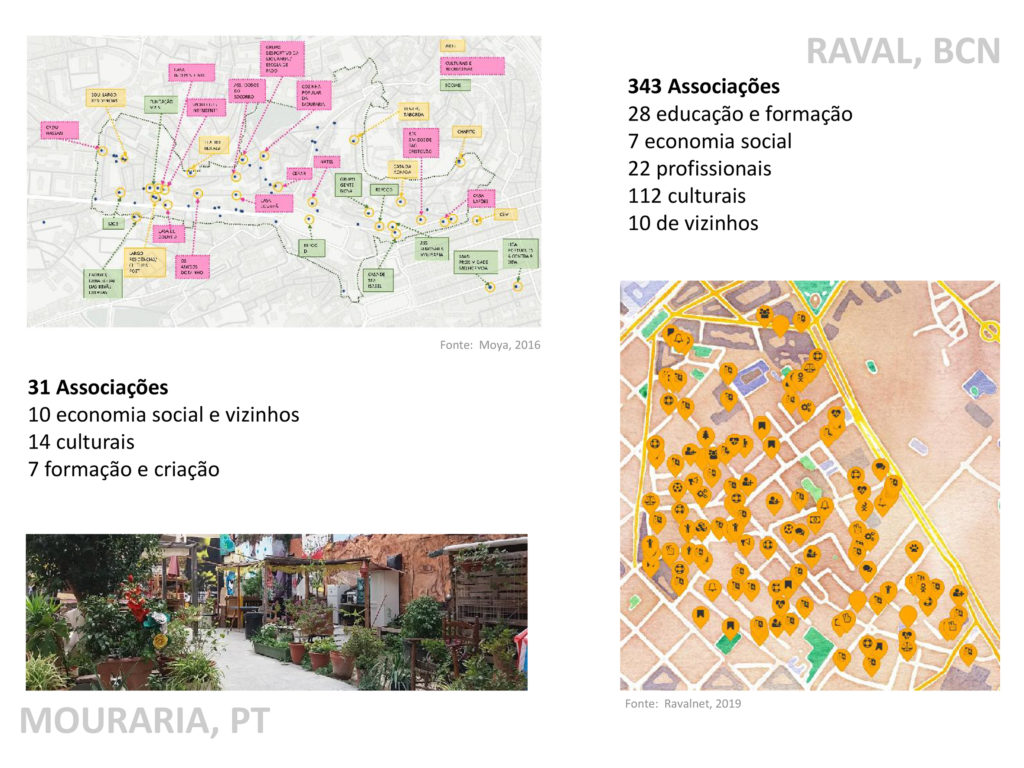
Cultural public institutions with a great impact in the neighbourhood such CCCB, MACBA, La Capella, Sta Mónica Art Centre, are involved and collaborate with other sociocultural and artistic associations in the neighbourhood. Many activities for the residents of the neighbourhood occur in Drassanes Civic Center and Casal de Barri Folch I Torres. They support territorial dynamization and educational programs carried out by associations. The Civic Centres give support to socio-cultural projects, with the offering of spaces. Priority is given to activities of social- cultural interest and community participation. The Casal de Barri, is also intended for community participation, socio-cultural development and cohabitation. There are several artistic associations in the neighbourhood closely involved with the residents and the community:
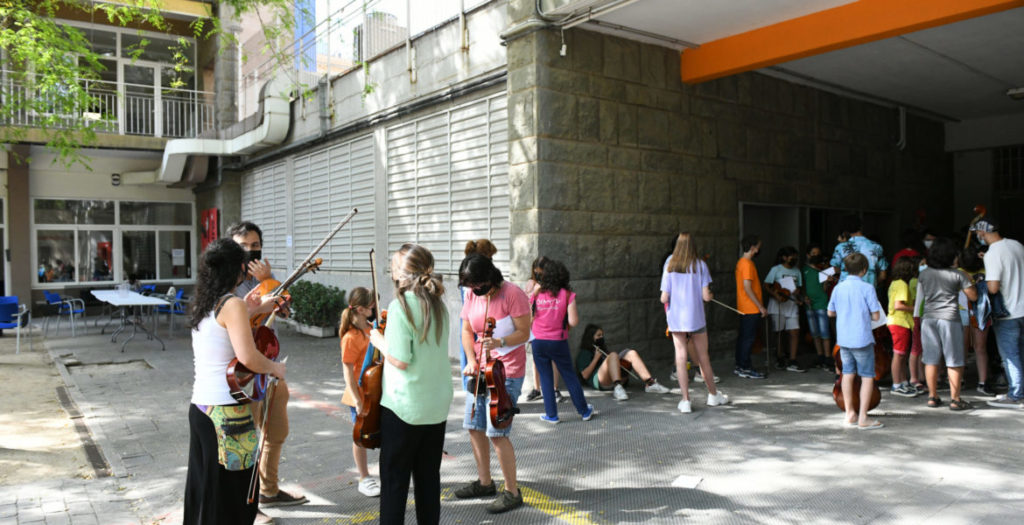 Xamfrà, Centre de Música i Escena del Raval (2004) (Raval Music and Performance Centre), is a meeting place for the arts. They develop a relevant socio-cultural work with young people and their families in the neighbourhood. The Centre won the National Cultural Price from Generalitat de Catalunya (2020) for their educational, social and inclusive work. They prioritize the value of the social and creative processes and give opportunities for artistic growth and interdisciplinary knowledge and educational opportunities in the performative arts from a socio-affective perspective. Their focus is on community human and cultural development, training and support using music, theatre and dance as tools for social inclusion and participation. They collaborate with a network of entities involved with collectives in risk of social exclusion, including not accompanied young immigrants in tutelage. Xamfrà has many years of experience in socio-education, with trans-disciplinary artistic projects. For example, the project of youth mobilization in Ciutat Vella with a trans-disciplinary work of theatre sessions, a musical group (Xamfrà Music Band), “La Batucada Jove del Raval” and “Tarda Jove” with musical trainings and rap sessions with the support network Migrate Youth, organized by Tot Raval. Left Image: Xamfrà music group at CESIRE building, Raval. Image source: www.xamfra.net
Xamfrà, Centre de Música i Escena del Raval (2004) (Raval Music and Performance Centre), is a meeting place for the arts. They develop a relevant socio-cultural work with young people and their families in the neighbourhood. The Centre won the National Cultural Price from Generalitat de Catalunya (2020) for their educational, social and inclusive work. They prioritize the value of the social and creative processes and give opportunities for artistic growth and interdisciplinary knowledge and educational opportunities in the performative arts from a socio-affective perspective. Their focus is on community human and cultural development, training and support using music, theatre and dance as tools for social inclusion and participation. They collaborate with a network of entities involved with collectives in risk of social exclusion, including not accompanied young immigrants in tutelage. Xamfrà has many years of experience in socio-education, with trans-disciplinary artistic projects. For example, the project of youth mobilization in Ciutat Vella with a trans-disciplinary work of theatre sessions, a musical group (Xamfrà Music Band), “La Batucada Jove del Raval” and “Tarda Jove” with musical trainings and rap sessions with the support network Migrate Youth, organized by Tot Raval. Left Image: Xamfrà music group at CESIRE building, Raval. Image source: www.xamfra.net
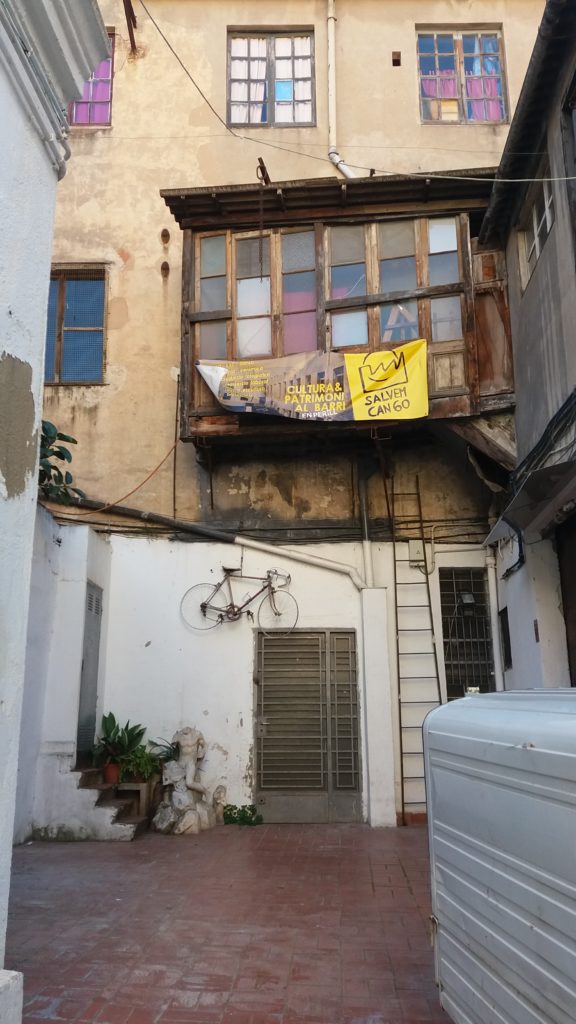 La Poderosa (2000) has been a very active association in Raval. They won Ciutat de Barcelona price (2016) for the Series “Hacer Historia(s)” and in recognition for their continuous work during more than fifteen years supporting the evolution of the urban artistic structure in the city. In the same year, they changed their headquarters, from the old factory building “Can Seixanta” in Raval, to Sants-Montjuïc district. During these years they were actively involved and compromised with the residents and artistic community participation in the neighbourhood. They were also involved in different Cultural Festivals in Raval such as “Festival Raval(s)” and organized Festivals such as “Site Specific Raval”(2015). They define themselves as a space of creation, research and cultural unrest, involved in all artistic and research languages related to the body and its performativity in Barcelona. They are accessible and give support to all dancing community, performing arts and experimental practices in the transversality of movement, body and dance.
La Poderosa (2000) has been a very active association in Raval. They won Ciutat de Barcelona price (2016) for the Series “Hacer Historia(s)” and in recognition for their continuous work during more than fifteen years supporting the evolution of the urban artistic structure in the city. In the same year, they changed their headquarters, from the old factory building “Can Seixanta” in Raval, to Sants-Montjuïc district. During these years they were actively involved and compromised with the residents and artistic community participation in the neighbourhood. They were also involved in different Cultural Festivals in Raval such as “Festival Raval(s)” and organized Festivals such as “Site Specific Raval”(2015). They define themselves as a space of creation, research and cultural unrest, involved in all artistic and research languages related to the body and its performativity in Barcelona. They are accessible and give support to all dancing community, performing arts and experimental practices in the transversality of movement, body and dance.
INCA Catalunya, International Network for Culture and Arts (2007), gathers professionals from the world of the arts, at it belongs to the international INCA Network. They work with theatre, animation, clown, social circus, dance and audiovisual techniques and they also target young participants and communities at risk of social exclusion, developing social intervention strategies, and an intercultural dialogue through performative arts. They carry-out educational training projects, produce cultural events, and offer spaces for artistic residencies and presentation. They also have developed projects in cooperation with other Raval’s socio-cultural and artistic associations, collectives and institutions. In 2017, they organized an Encounter of Applied arts (Aplec d’Arts Aplicades), with the theme “Art in the service of communities”. This seminar allowed the gathering of more than twenty institutions and professional in order to reflect on the importance of participative and community arts (Theater, performance, circus, dance, poetry, music) as tools for social transformation. Right image: Can Seixanta Factory Building, in Riereta Street, former headquarters of La Poderosa and INCA Catalunya associations. Source: A. Moya.
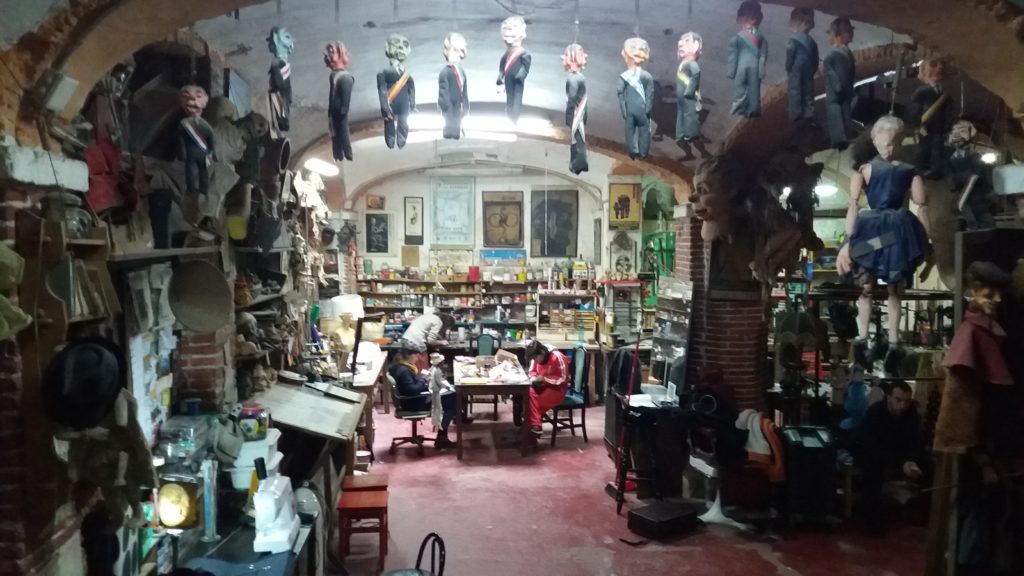 Other relevant artistic associations are: Forn de Teatre Pa’tothom. It is an association that wants to integrate different cultural expressions using theatre as a tool to help people and vulnerable groups. With a leisure and educational spirit, with the objective to activate the social dinamization. Pa’tothom fights against structures that favour social exclusion specialized in Theatre of the Oppressed (A.Boal). Almazen (1998), also known as La Ciutat de les Paraules Cultural Association, is a space for artistic creation and artistic dissemination addressed to contemporary clown, visual and scenic arts, micro-circus, oral narratives and experimental cinema. They involve the neighbors, with interventions and actions in public space, sharing the work of art with the residents (Poesia Involuntaria project). Their objective is the creation of tools for social cohesion with the environment through the arts. We could also mention important associations such as Puppet House and Workshop Pepe Otal; Cronopios Club, literary cultural association with literary events, poetry and philosophy; The Cat Factory, gastronomic and cultural space (the cultural aspect involves the promotion of the arts, exhibit space and organization of Festivals); Mucha Fibra Association (2008), addressed to the experimentation in fashion learning; The collective: Creative Lab (Filmmaker hub), among others. Right image: Inside the headquartes of Puppet House and Workshop Pepe Otal. Source: A. Moya.
Other relevant artistic associations are: Forn de Teatre Pa’tothom. It is an association that wants to integrate different cultural expressions using theatre as a tool to help people and vulnerable groups. With a leisure and educational spirit, with the objective to activate the social dinamization. Pa’tothom fights against structures that favour social exclusion specialized in Theatre of the Oppressed (A.Boal). Almazen (1998), also known as La Ciutat de les Paraules Cultural Association, is a space for artistic creation and artistic dissemination addressed to contemporary clown, visual and scenic arts, micro-circus, oral narratives and experimental cinema. They involve the neighbors, with interventions and actions in public space, sharing the work of art with the residents (Poesia Involuntaria project). Their objective is the creation of tools for social cohesion with the environment through the arts. We could also mention important associations such as Puppet House and Workshop Pepe Otal; Cronopios Club, literary cultural association with literary events, poetry and philosophy; The Cat Factory, gastronomic and cultural space (the cultural aspect involves the promotion of the arts, exhibit space and organization of Festivals); Mucha Fibra Association (2008), addressed to the experimentation in fashion learning; The collective: Creative Lab (Filmmaker hub), among others. Right image: Inside the headquartes of Puppet House and Workshop Pepe Otal. Source: A. Moya.
Casa Fábrica: Ateneu del Raval (2016), Cultural Communitarian Centre, is a socio-cultural association that searches the intercultural exchange and reflection in all the disciplines of knowledge and cultural expressions, empowering the social fabric of the neighbourhood. Their objective is to use culture as a method of integration and social participation always involved in their urban fabric, neighbouring communication, immigration, participation, cultural, social and community promotion. In 2016, the association rehabilitated the former Lloberas Factory House abandoned for six years. They promote and strengthen ties with other Raval’s associations and sociocultural institutions, including collaborations with Tot Raval, INCA Cultural Association, and it has created the Federation of Cultural Associations “Red Cultural Barcelona”. They have developed numerous projects around the themes of historical memory, feminism, interculturality, human rights, sexual diversity and anti-racism, among them “Talking about the House Factories” or the Memory workshops with youth and children in the project “Migrants Memory” (Memòria dels Migrants). Ateneu also gathers and give space to other neighbourhood entities (civic and social associations, groups and foundations) that organize assemblies, talks, exhibitions, neighbourhood meetings, community lunches, book presentations, among others. Below: Communitarian lunch gatherings at Ateneu Raval association. Source: Ateneu Raval.
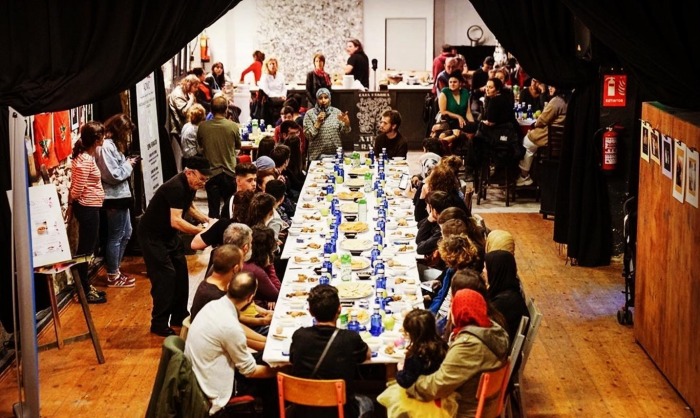
Associations addressed to Raval’s social and multicultural integration are Associació de Dones Marroquines a Catalunya; El LLoc de la Dona, involved with institutions that work with women in Raval; Intercultural Association Diàlegs de Dona; INDERA Foundation that works with the Human Rights of Women, genre consulting and pro-equity programs; ACESOP cultural association, operative with Pakistani women; Fundació Bayt al-Thaqata; Association of sub-saharan inmigrant women; Ibn Battuta Foundation that promotes cultural and social exchange and the dissemination of scientific knowledge between Maghreb, Islam and Spain; Intercultural association Punt Comú; Punt d’Intercanvi socio-cultural association; Casal dels Infants del Raval; Cooperativa Impulsem (SCCL); Fundació Raval Solidari; Raval Interrreligious Group; Centre of African Studies; TEB and Collectic association that works with youth (16-20 years old); Casa del Immigrante del Raval; Casa de la solidaritat – El Lokal; El Mirador dels Immigrants; among others.
There are also entities that gather associative networks in Raval, such as Raval Dona, which gathers all the entities that give support to women in the neighbourhood; Raval Cultural network, which gathers collectives, cultural and artistic spaces, training centers, artistic groups, exhibition spaces, galleries, the film library, entities and associations, academic and research institutions, bookstores, museums and cultural facilities, musical training, heritage and theaters. TotRaval Foundation (2002) is a platform that gathers cultural and social institutions, commercial associations, and educational centers. They create networks of neighbourhood cooperation. They develop the programs Ravalnet that work in different projects: “Territori Socialment Responsible”, or “Festival Raval(s): Festival de Cultura Comunitària” (Festival of community culture).
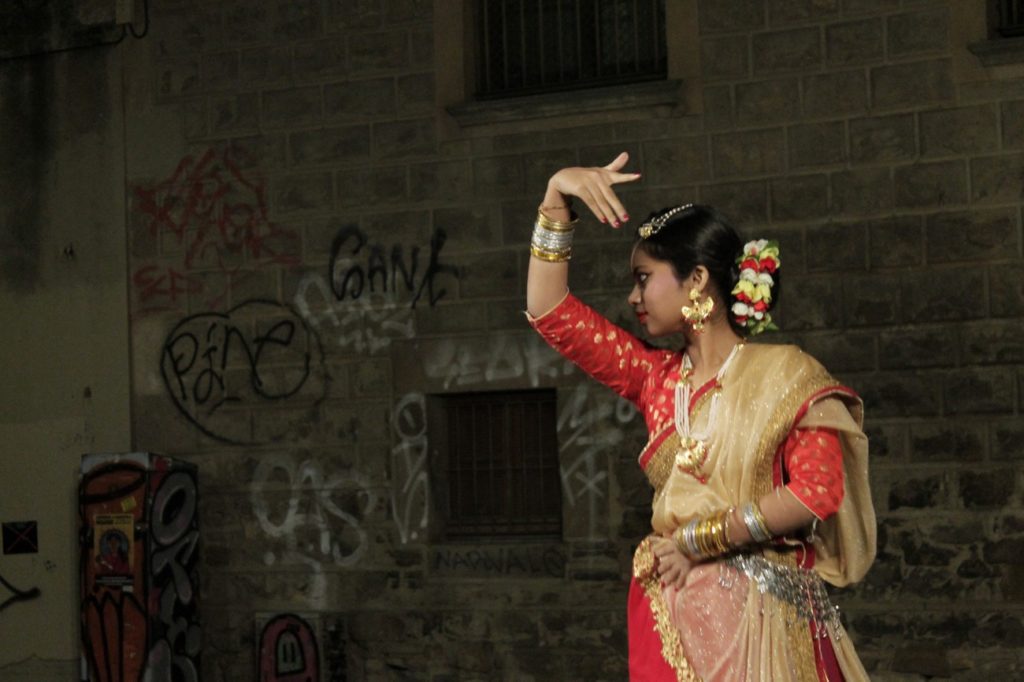 In 2018, the Cultural Festival Raval(s) was in its 16th edition. Its first edition, in 2003, started as an initiative of TotRAval, with a series of activities and itineraries in the neighbourhood, with the participation of five associations and entities. Nowadays, eighty associative participants, with a total of 900 people, are implicated and involved. It is a Festival created by the neighbourhood residents, which builds a community, fosters a sense of identity and co-responsibility towards the neighbourhood, creating a sustainable urban space and a sense of belonging. The Festival gives emphasis to the people, their cultural diversity, promoting community participation through processes of artistic participatory creation from a diversity of artistic and cultural perspectives, and it counts with the contribution of all the artistic and socio-cultural associations settled in Raval. It takes place every year in the first week of November. The year 2020, however, with the arrival of the Covid-19 pandemic, challenged the Festival organization and implementation, forcing to strengthen the neighbourhood networks through digital media and presenting a program of activities online. Left image: Dance performance at Cultural Festival Raval(s) (2018). (Source: www.totraval.org)
In 2018, the Cultural Festival Raval(s) was in its 16th edition. Its first edition, in 2003, started as an initiative of TotRAval, with a series of activities and itineraries in the neighbourhood, with the participation of five associations and entities. Nowadays, eighty associative participants, with a total of 900 people, are implicated and involved. It is a Festival created by the neighbourhood residents, which builds a community, fosters a sense of identity and co-responsibility towards the neighbourhood, creating a sustainable urban space and a sense of belonging. The Festival gives emphasis to the people, their cultural diversity, promoting community participation through processes of artistic participatory creation from a diversity of artistic and cultural perspectives, and it counts with the contribution of all the artistic and socio-cultural associations settled in Raval. It takes place every year in the first week of November. The year 2020, however, with the arrival of the Covid-19 pandemic, challenged the Festival organization and implementation, forcing to strengthen the neighbourhood networks through digital media and presenting a program of activities online. Left image: Dance performance at Cultural Festival Raval(s) (2018). (Source: www.totraval.org)
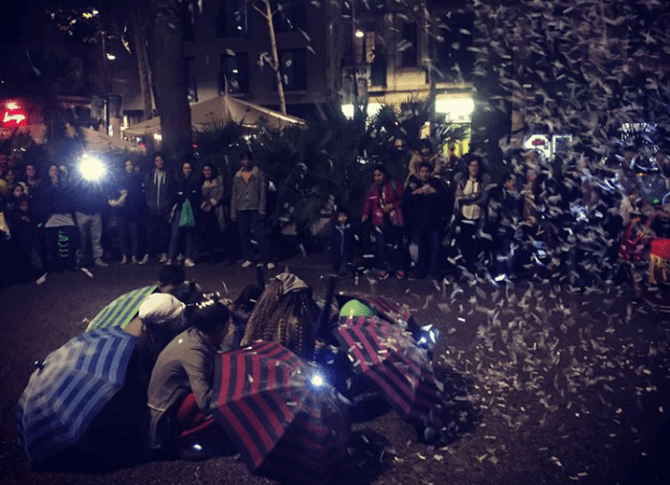 The artistic communitarian spectacle “Lluernes d’Hivern” (“Winter lights”) (2017-18), was directed by INCA Catalunya association and co-produced by TotRaval Foundation, linked to the project #Ravalkm0, directed by Impulsem SCCL and TotRaval Foundation, related to the Festivities of the first Christmas lights in Raval. This project was part of ArtiPart program of community artistic creation in the neighbourhoods, from Institut de Cultura de Barcelona. ArtiPart selected five community creations promoted in five neighbourhoods (Marina, Poblenou, Raval, Sant Andreu, Sant Pere, Santa Caterina and Ribera). In Raval, “Lluernes d’Hivern” was a two years participative theatre laboratory and a collective spectacle of communitarian creation to be performed as a collective itinerant performance in the public spaces of the neighbourhood during two editions, in November each year. The first edition (2017) that took place from October to November, involved the participation of more than thirty collectives, associations and groups in the neighbourhood. It was a collective spectacle around Raval’s cultural diversity and the winter solstice multicultural rituals, with its myths, stories and legends. It also counted with the collaboration of La Capella, La Massana, CCCB, MACBA, among others institutions. In the second edition (2018), the theme was the Gardens of Rubió I Lluch, with the objective of transforming them in a magic space where everyday stories mix with characters and historic events. It counted with the collaboration of El Gecko con Botas, La Capella, Escola Massana, Bastoners del Raval, AIPCC, Escola de Músics i JPC, Xamfrà, the Catalan Bolivian Centre, Diàlegs de Dona, Capoeira Palmares BCN, among others. Right image: Itinerant performance “LLuernas d’Hivern” (2017). (Source: www.totraval.org). Below: Popular Cercavila with giants (gegants, gegantots) and catle (bestiari), Cultural Festival Raval(s) (2018). (Source: www.totraval.org)
The artistic communitarian spectacle “Lluernes d’Hivern” (“Winter lights”) (2017-18), was directed by INCA Catalunya association and co-produced by TotRaval Foundation, linked to the project #Ravalkm0, directed by Impulsem SCCL and TotRaval Foundation, related to the Festivities of the first Christmas lights in Raval. This project was part of ArtiPart program of community artistic creation in the neighbourhoods, from Institut de Cultura de Barcelona. ArtiPart selected five community creations promoted in five neighbourhoods (Marina, Poblenou, Raval, Sant Andreu, Sant Pere, Santa Caterina and Ribera). In Raval, “Lluernes d’Hivern” was a two years participative theatre laboratory and a collective spectacle of communitarian creation to be performed as a collective itinerant performance in the public spaces of the neighbourhood during two editions, in November each year. The first edition (2017) that took place from October to November, involved the participation of more than thirty collectives, associations and groups in the neighbourhood. It was a collective spectacle around Raval’s cultural diversity and the winter solstice multicultural rituals, with its myths, stories and legends. It also counted with the collaboration of La Capella, La Massana, CCCB, MACBA, among others institutions. In the second edition (2018), the theme was the Gardens of Rubió I Lluch, with the objective of transforming them in a magic space where everyday stories mix with characters and historic events. It counted with the collaboration of El Gecko con Botas, La Capella, Escola Massana, Bastoners del Raval, AIPCC, Escola de Músics i JPC, Xamfrà, the Catalan Bolivian Centre, Diàlegs de Dona, Capoeira Palmares BCN, among others. Right image: Itinerant performance “LLuernas d’Hivern” (2017). (Source: www.totraval.org). Below: Popular Cercavila with giants (gegants, gegantots) and catle (bestiari), Cultural Festival Raval(s) (2018). (Source: www.totraval.org)


